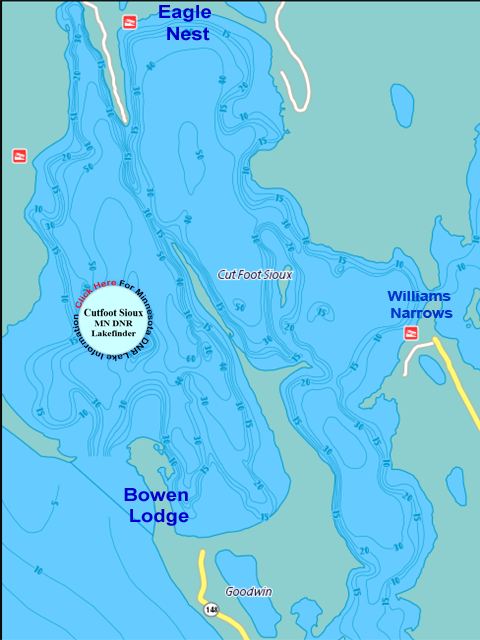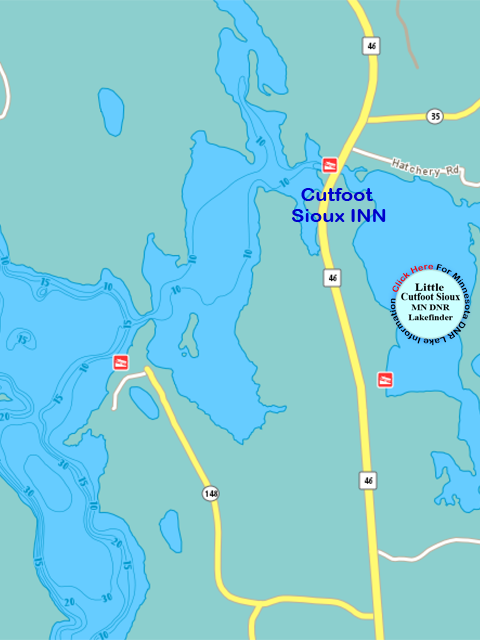 |
Cutfoot Sioux and Little Cutfoot Sioux Lakes are connected to Lake Winnibigoshish and are an integral part of the “Winnie Walleye Factory”. Walleye eggs taken each spring at the Cutfoot Sioux Stripping Station and hatched at the Grand Rapids Hatchery account for improved Walleye fishing in a host of Minnesota Fishing Lakes. The Cutfoot chain of lakes offers one of the areas most diverse fisheries offering everything from panfish to Muskies. There is virtually never a time when there isn’t some good fishing going in either Cutfoot or Little Cutfoot Sioux. Although Cutfoot is famous for it’s Walleye angling, quality size Bluegill, Crappie, Perch, Musky and Pike are also available. Protected waters, gorgeous scenery and fantastic viewing of Bald Eagles make Cutfoot a joy to visit, even during rough weather. Cool water period: For it’s size, Big Cutfoot Sioux offers more good Walleye fishing spots per acre than practically any other lake in the area. In spring and fall, Walleyes use the lakes many shoreline points and weedbeds to navigate from one good feeding spot to another. Typically, best Walleye fishing technique during cool water periods are jig and minnow combinations. Fish in depths of 6 to 12 feet and pay particular attention to weed beds, gravel and rocks. Cutfoot Walleyes like current, so you’ll have better results fishing on the breezy spots. Warm Water Period: During summer, Walleye use the deeper points and main lake structures as “resting areas” but will frequently move into shallower water for the morning and evening periods. Warm water is a great time to fish with Night Crawlers and Leeches on Cutfoot. Use live bait rigs with a four to five foot leader, bullet sinker and a number 4 hook. Start at the weedline and gradually work out to deer water. During mid-summer, there are always some Walleyes in the weeds. One great approach is to use a small jig in the 1/16-ounce range tipped with a night crawler. The light jigs can be cast into the heavier weeds and fished with a minimum of snagging. Panfish are present in all areas of Big Cutfoot and the size structure is excellent. Crappies, Bluegills and Redear Sunfish are the most common to catch, but Hybrid Sunfish and Rock Bass are caught too. Click on Map Images for links. Click on lake name for link to the Minnesota DNR Lakefinder. The link will jump directly to the Lake Winnibigoshish Information Page . |
Mid-Summer Panfish can be hard to track down, especially during the daytime. They are typically located in heavy, submerged cover. The mixture of Coontail, Cabbage and Northern Milfoil can produce heavy mats of weeds where panfish can hide stubbornly. They do feed heavily during summer though and the best way to catch them at feeding time is by fishing the lake during early morning and at sunset. Crappies and Sunfish cruise along the weed edges making active feeding runs during these low light periods. Jumbo Perch fishing on the Cutfoot Sioux Chain can produce excellent catches of Perch. Although, Lake Winnie is better known for its Perch fishing, these scrappy fish will find sand and gravel areas adjacent to the bulrush patches in Cutfoot too. Perch can be caught on a variety of baits like jig & minnow combinations, live bait rigs tipped with medium size minnows and even plain hooks fished below a bobber rig. Largemouth Bass of great quality are commonly caught in the Cutfoot chain of lakes. Casting toward the weeds on shallow flats with access to deeper water is the key to locating bass. Spinnerbaits, weedless frogs and soft plastics will trigger some fine bass action. |
|
 |
Little Cutfoot Sioux, connected to both Big Cutfoot and Lake Winnibigoshish is the spring headquarters of the “Winnie Walleye Factory”. Walleye eggs taken each spring at the Cutfoot Sioux Stripping Station and hatched at the Grand Rapids Hatchery account for improved Walleye fishing in a host of Minnesota Fishing Lakes. Walleyes remain in Little Cutfoot for a period of time after the spawn. But the lion's share do move back through the channel and out toward Big Cutfoot and Lake Winnie. Still, there are some "resident Walleyes" that stay behind and there anglers who catch them throughout the summer. Typically, trolling the weed edges with Lindy Rigs or Spinners tipped with live bait is the best presentation. During mid-summer, fast moving crawler harness spinners equipped with large blades and tipped with night crawlers will produce some Walleyes. Unlike Big Cutfoot, it's rare for any large number of Walleyes to return in the fall. Never rule out the presence of scattered groups, but if you're fishing Little Cutfoot, plan to take advantage of the superior panfish action instead. Panfish are present in all areas of Little Cutfoot and Bluegill, Crappie and Jumbo Perch consistently reward anglers who find them. Super catches of panfish are common throughout the season. During spring, panfish are found in heavy vegetation along the shoreline. At times, anglers would be well adised to fish with Cane poles instead of casting with spinning gear. Panfish can be located so tight to the cover that they are overlooked by fishermen concentrating on the outer edges of vegetation. Click on Map Images for links. Click on lake name for link to the Minnesota DNR Lakefinder. The link will jump directly to the Lake Winnibigoshish Information Page . Click Here to >> Book A Guided Fishing Trip On Little Cutfoot. |
|
|
| See More Fishing Articles, Fishing Reports and Fishing Videos click >> Fishing Archives Section . | |